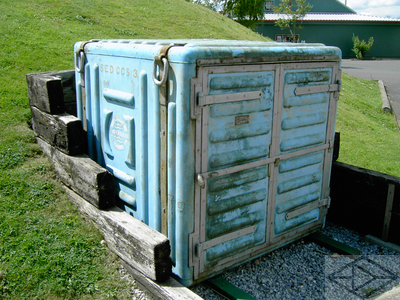
One of the last, if not the very last, train of 'Tom Puddings' at Goole in 1984 - during the coal strike. At the far end of the train is what is now Acasters wharf and the Yorkshire Waterways Museum beyond. This was when Britain was still a net EXporter of coal rather than an IMporter!
Loaded upstream directly from one of a number of collieries, these trains were brought down to Goole in trains like this behind a tug, and then lifted bodily out the water and tipped from a great height into waiting sea-going vessels.

Going back to the beginning, there was a need to get coal in large quantities from waterside collieries, such as this one, both to Goole for onward shipping by coaster and also to waterside power stations - notably those at Ferrybridge. The engineer WH Bartholomew devised the Tom Pudding system where relatively small compartment boats could be interlocked simply in trains and then loaded directly into waiting vessels. Some of these tom puddings were loaded directly by shute at the colliery waterside, others at rail connected wharves but in one case by actually taking the tom puddings themselves by rail to a more distant colliery.
The trains were originally intended to be push-towed by one of seven tugs, but in the event they were towed conventionally behind the tugs - such as Wheldale here preserved at the Yorkshire Waterways Museum.

Because the tom puddings were essentially square boxes, a lot of the force from the tug's propeller would be wasted and so a 'false bow' known as a 'jebus' was attached to the front of the train behind the tug. Here is 'Jebus No3', again at the Yorkshire Waterways Museum. When the tom puddings had been emptied, this was not so much of an issue and the jebus would be pushed in front of the tug on the way back to the loading wharf.


At Goole, the trains would be worked though the hoists and each compartment lifted, one at a time and tipped before being slotted back into the train and the next tub lifted. The coal then fell down the chute (shown here in the 'out of the way' raised position) into the ship below. There were five hoists at one time - but this one, No5 in the south dock, is the only one remaining. It is no longer in use but has been preserved, along with a few Tom Puddings, out of heritage interest.

Also in the docks is this similar hoist. This one however received railway trucks, over he brick arch to the rear, which were tipped over, in a way similar to the Tom Puddings, to load ships in the dock.

Finally, almost unnoticed by most people is this glassfibre box - about 6 feet cubed. These were an early (mid 20th century) form of containerisation. They were introduced by British Waterways for use in the barge trade throughout the north-eastern waterways. They could fit two across the width of a typical barge and many more along the length. They also had the advantage that they could be locked, sealed and 'bonded' to UK customs specification. Sadly, this form of containerisation never really took off and many of these ended up as garden sheds and the like! Once there were so many. Incidentally, another form of this glass fibre container was introduced for narrow boats. It had a tumblehome to match the cabin sides and four would fit along the hold. Again, it never was fully utilised and the last known was as a garden shed at Wychnor Lock before its importance was recognised and it became an exhibit at the Waterways Museum at Ellesmere Port.